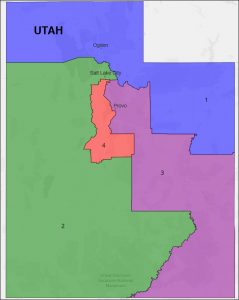By Jim Ellis
Nov. 12, 2021 — Two new proposed redistricting maps were released early in the week, both of which the Dave’s Redistricting App personnel, from the statistical analysis website that specializes in redistricting, call partisan gerrymanders. Democrats drew the Nevada map in anticipation of the special state legislative session beginning next week; Republicans crafted the Utah plan that has now cleared both houses of the state legislature.
In 2020, two of the Las Vegas area congressional districts turned in close re-election victories for Democratic incumbents, Rep. Susie Lee (District 3: 49-46 percent) and Rep. Steven Horsford (District 4: 51-46 percent). The Democratic controlled legislature is looking to improve their districts, from a partisan perspective, but that comes at the expense of Rep. Dina Titus’ downtown Las Vegas CD (District 1) that will become more competitive should this map be enacted as currently drawn. Titus’ 2020 victory spread was 62-33 percent.
The Utah Republican legislature’s redistricting team has designed a new map that would give all four Republican incumbents equivalently strong GOP districts. The big winner is freshman Rep. Burgess Owens (R-Salt Lake City), who sees his marginal district grow from one that produced only his plurality Republican victory over then-Rep. Ben McAdams (D) into the safest Republican seat in the state.As with many of the smaller population western states with an expansive land mass and one metropolitan area that dominates the entity, the Republican map drawers chose a pie-shaped option, that is a plan where all of the state’s congressional districts share a piece of, in this case, the Salt Lake City metro area.
The Nevada map, on paper, is designed to send three Democrats and one Republican to the US House. The lone Republican, Rep. Mark Amodei (R-Carson City), will again have the northern 2nd District, a seat too far from Las Vegas to take any part of the metro area.
The geography, and the number of people in Nevada’s northern sector, makes drawing a 4D-0R map almost impossible. Therefore, in order to help craft three districts that Democrats should win in typical election years, the map drawers packed as many Republican voters as possible into the one northern district.
Dave’s Redistricting App’s analysts divided the new districts on a partisan basis, but their percentages are estimates. Almost 30 percent of the Nevada electorate registers as Nonpartisan, so dividing only into Democrat and Republican segments may not be particularly accurate.
Using their estimates, however, Democratic registration and their share of the nonpartisans would fall in the 52-53 percent range in Districts 1, 3, and 4, those fully contained within, or where Clark County is dominant. The Republican share would be in the 44-45 percent range in each. In the northern 2nd District, the GOP factor would be approximately 54 percent, as compared to the Democrats’ 43 percent.
While the three Clark County seats obviously favor the Democrats, the numbers are not overwhelming, meaning over the course of the decade and with Republicans of late performing better among Hispanics – the three proposed Clark County CDs average 27.2 percent in Hispanic population – these seats may become more competitive than currently meets the eye.
Utah, the fastest growing state in the country during the last decade, has four congressional districts that will house over 817,000 people apiece. If the state continues on its present population growth pace, the delegation should be in position to gain a fifth seat after the 2030 census.
Dave’s Redistricting App also published projected partisan division numbers for the four proposed Utah seats. Districts 1 (Rep. Blake Moore-R), 2 (Rep. Chris Stewart-R), and 3 (Rep. John Curtis-R) would show a Republican partisanship estimate between 55-57 percent in each of the three CDs. Republican Owens’ 4th District Salt Lake City seat would top 60 percent.


